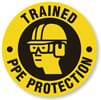The Basics of Respiratory PPE
Confined spaces can present plenty of breathing hazards, especially when air quality might be a concern. Personal protective equipment, or PPE, is necessary on any job site, but it becomes especially critical to protect workers when their breathing or lungs might be jeopardized. Let’s learn more about the basics of respiratory PPE.
Respiratory Protection Programs
Government organizations such as the Occupational Safety and Health Administration (OSHA) and the National Institute of Safety and Health (NIOSH) issue regulations regarding respiratory PPE and their associated programs. All companies and employees must abide by these regulations, especially the ones that relate to heavy industry. Respiratory protection programs are meant to train workers how to use respiratory PPE and how to avoid the risks posed by airborne contaminants in the form of dust clouds and vapor clouds. Lead, ammonia, and asbestos are some of the most common contaminants industrial workers will encounter. What are some of the key points every good respiratory protection program should contain?
- Written information regarding how the plan will be carried out.
- Risk assessments based on known hazards on the job site.
- Inspection procedures for checking the condition of equipment and how to make repairs, if necessary.
- Evaluations of the workers’ ability to properly use the respiratory equipment.
How to Recognize Hazards
Learning what the hazards are and recognizing signs of them during potentially hazardous operations are two different things. In general, toxic and poisonous substances can infiltrate the human body in three ways:
- The lungs
- The skin
- The gastrointestinal tract
The lungs are the most vulnerable point of entry for any dangerous substances. Oxygen goes directly into the bloodstream, and anything inhaled will follow that same circulation method. There are three classes of respiratory hazards to account for in your program materials:
- Oxygen-poor air
- Dust and debris particulates
- Clouds of gas and other vapors
Different Types of Respiratory PPE
The two main types of respiratory PPE are known as air-purifying and air-supplying. The air-purifiers excel when used against dust and debris particulates as well as gases and vapors. Chemical cartridges and filters are essential components of these pieces of equipment. Gas masks are also another key part of the air-purifier.
However, air-supplied respirators work slightly differently. With an air-supplied respirator, a constant stream of clean air is provided for the user. A self-contained breathing apparatus and air-line devices are two examples of an air-supplied respirator. Self-contained breathing apparatuses should be used in situations where the air pollution can be life-threatening. Meanwhile, air-line devices are meant to be deployed in areas where the air is polluted but not life-threatening, because the air supply can last for long periods of time before needing to be refilled.
Prioritize Safety with G&M Services
G&M Services is proud of our employees and the dedication they have for safety in the workplace. Our employees are also rewarded for positive safety practices. We incorporate weekly and monthly discussions and meeting to ensure that all involved are aware of how to handle equipment and potential situations that could occur during a project.
G&M Services offers services in the way of concrete drilling and sawing, concrete scanning and FireStop. To get started with us, call today at 410-787-8828 or visit our contact page. Follow the official company page today on Google+, Facebook, Twitter and LinkedIn.









